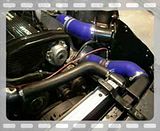First a word about the name of my project.
The wasp دبور because of the funny noise it makes and because it is the name of a place where young people gathered in the town where I was born. Not to be confused with the legendary Wasp-engine.
To get this project-thread in its context I found it useful to start with a bit of history.
A friend told me that he was looking around for another car and that he might have found a very interesting one because of its high power but low displacement and thus low taxes.
In the end he didn't buy it but on my side the interest had aroused.
That time I was driving my old Peugeot 104. That was a hybrid made with the cylinder head from the 1219cc engine with two Weber DCOE's and a 1360cc lump and also a lightened flywheel.
Pretty nervous car, weighting less than 800kg :-) But it was getting very rusty and because bodywork has never been my thing I was more or less looking for something else too.
You can imagine what happened, a couple of months later I was driving a S13.
That was end 1999.
Not that much later it was also the time for my first PC and the first steps on the internet.
Since then, a lot of things happened.
Crashed the car in 2005 (my bad), bought another one a couple of weeks later. Same color, the colleagues didn't even notice the difference LOL
Over the years there's probably not much that I haven't been touching on this car.
I'll post some pics very soon.
In the beginning it was all mainly engine related.
Then a couple of years ago, regulations here became more and more strict and these days only very few is allowed to mod legally. First I have been re-fitting stock exhaust, ARB's, brake callipers and hoses for the anal, sorry annual tech check but after two times I got fed up with this bullshit and I decided to keep the car track/hobby/illegal only and I bought me a grandpa-car as daily driver.
With the first trackdays it became clear that engine mods are not enough to be fast and that was the time that suspension works started.
After some time I found myself with a pretty well driving and handling car, not the max but enough to have decent fun
But in fact, the aim was not to drive on track, the aim was to modify and test on track.
In all this modifying with no beginning and especially no end, the wet dream was to try something that had been laying on the shelf for some time.
To be continued...






 Reply With Quote
Reply With Quote













